Welcome again to Books At a Glance as we continue our brief discussions tracking out the Dutch Reformation. I’m Fred Zaspel, and we are talking again to Dr. William Vandoodewaard—this time about the Belgic Confession.
Bill, who was the author of the Belgic Confession of Faith, and what was the context of his writing it?
Vandoodewaard:
Sure, thanks Fred. The author of the Belgic Confession of Faith was Guido de Bres, a reformed theologian. He was born in 1522 and died in 1567. He was actually an artist or a glass painter by profession. So, by his profession he would be very much involved in the art that would have been found within the typical Roman Catholic Church.
Zaspel:
When did the Belgic Confession of Faith gain ecclesial acceptance? When was it adopted by Reformed churches?
Vandoodewaard:
I’ll just walk through a little bit more of de Bres’ life here, before I get into that question.
De Bres himself had become convinced of the necessity of Reformation in the church and actually moved to London, England for a time in his 20s. This was during the window of the rule of Edward VI. Here he studied for the ministry and sat under the preaching of Jan Alasky and Martin Bucer; both, of course, great reformed theologians. He returns back to the southern province of the Low Countries at the age of 30. There he moves to Lille where there is a large underground Protestant congregation called the Church of the Rose. He spends time there; he will actually travel to Geneva; he spends three years under the teaching of John Calvin; and then by 1559 he returns back to the southern provinces of the Low Countries. He preaches at Antwerp and a number of other cities; he serves for a time in a town called Doornik. And after the martyrdom of several other Protestant ministers in this region, he flees for a time to northern France; but then he comes back again to Antwerp to pick up ministry again. There he will be captured and hanged by the Inquisition.
Well, de Bres, then, was a passionate gospel preacher, very much devoted to seeing the advance of the Gospel of the Lord Jesus Christ in the Low Countries, and knowing that he is ministering in a place of persecution and returning to that. His vision in framing the Belgian Confession of Faith was much like Calvin’s Institutes. A desire to both strengthen the church, build up the faith of the church, and having a clear understanding of the doctrines of Scripture; but, at the same time, to provide really, in a sense, an appeal, in this case, to Philip II to end persecution by setting out the reasonableness, the Scriptural grounds for with the Reformed churches believed.
Zaspel:
That’s interesting. I think the Reformation in the Low Countries is something that’s often overlooked here in the states. We’re glad to have you doing this for us.
What does the Belgic Confession of Faith teach? Can you give an overview of its content?
Vandoodewaard:
Sure. Just beginning with the prefatory comments that would have been appended to it. Typically, if you look at a copy of the Belgic Confession of Faith in a collection of creeds and confessions, you wouldn’t necessarily have this appended to it. But de Bres and the other signers to this Confession declared that they were ready to obey the government in all lawful things, but that they would offer their backs to stripes, their tongues to knives, their mouths to gags and their whole bodies to the fire rather than to deny the truth of the Gospel of the Lord Jesus Christ of the Word of God expressed in this Confession. So, it’s very much a confession of faith under persecution.
It was written in 1563. It would be adopted at an underground church Synod in Antwerp in 1566 and widely disseminated around that time. To give you a bit of an outline, it really follows what we would call the six loci of Reformed Systematic Theology. It opens up by looking at the doctrine of God, and that would be the first 11 articles of Theology proper. Then it gets into the doctrine of Man, Anthropology, in articles 12 through 15; the doctrine of Christ in articles 16 through 21; the doctrine of Salvation in articles 22 through 26; the doctrine of the Church, Ecclesiology, in articles 27 through 35; and then the Last Things in article 37. Article 36 looked at church government, as well as the relation of the church and state. So really, a systematic theology in a small package is what we find in the Belgic Confession.
Zaspel:
How was the Belgic Confession of Faith significant to the wider Reformation and into the post-Reformation era?
Vandoodewaard:
It was one of the early reformed confessions that would have a significant influence. It really stands alongside, in this era, the Scots Confession in Scotland; the Articles, of course, under Edward, that are formed in England; and then the Genevan Confession, in terms of confessions that have a distinctively reformed orientation, as well as the Helvetic Confession of the Swiss, and the Gallican, a French Confession of 1559. So, it stands in that family of early Reformation confession. Its most significant, as a Confession itself, for its influence into the Low Countries. It was translated into Dutch early on; it was written initially in French. It was adopted, as I mentioned, by the Synod of Antwerp in 1566 and it would be regularly readopted, or re-subscribed by Dutch synods through the subsequent decades of the 16th century. It’s very influential as the Confession of these churches that are being planted, that are growing, that are, in time, flourishing in the Low Countries. Also significant, as we move forward, it continues to the present day to be a confession of faith of Dutch Reformed denominations around the world. But would also be influential in the nearer term, post-Reformation era, among those that would write the Westminster Confession of Faith. So they would be looking at the Belgic Confession and Scots Confession, the Genevan Confession, and drawing in part from those confessions. And that, of course, bearing influence as well into the London Baptist Confession.
Zaspel:
What is the value of this Confession of Faith today?
Vandoodewaard:
I would say that the Belgic Confession is of great value. I think many of us, at least in the Presbyterian tradition, look to the Westminster standards, the Westminster Confession of Faith. In the Baptist tradition, many would look to the London Baptist Confession. The Belgic Confession, as an earlier Confession, I think, is very helpful in its succinctness. It’s a shorter Confession, but it deals with all of the areas of Reformed Systematic Theology. Not as extensively as some of the later confessions, but in a way, that’s very helpful. I think it’s a great place for people in the evangelical reformed world, who want to get a handle on reformed theology, a great place to begin, to open it up, to study, to read through, to look at Scripture references and really get a good sense for these beautiful doctrines that the Word of God proclaims.
Zaspel:
We’re talking to Dr. William Vandoodewaard about the Dutch Reformation. We hope you’ll join us again here at Books At a Glance as we continue our conversations about the Dutch Reformation—next time we’ll talk about the Heidelberg Catechism.
Editor’s Note: Be sure to take a look at these books by Dr. Vandoodewaard.
The Quest for the Historical Adam
Books At a Glance Author Interview.
The Marrow Controversy and Seceder Tradition

